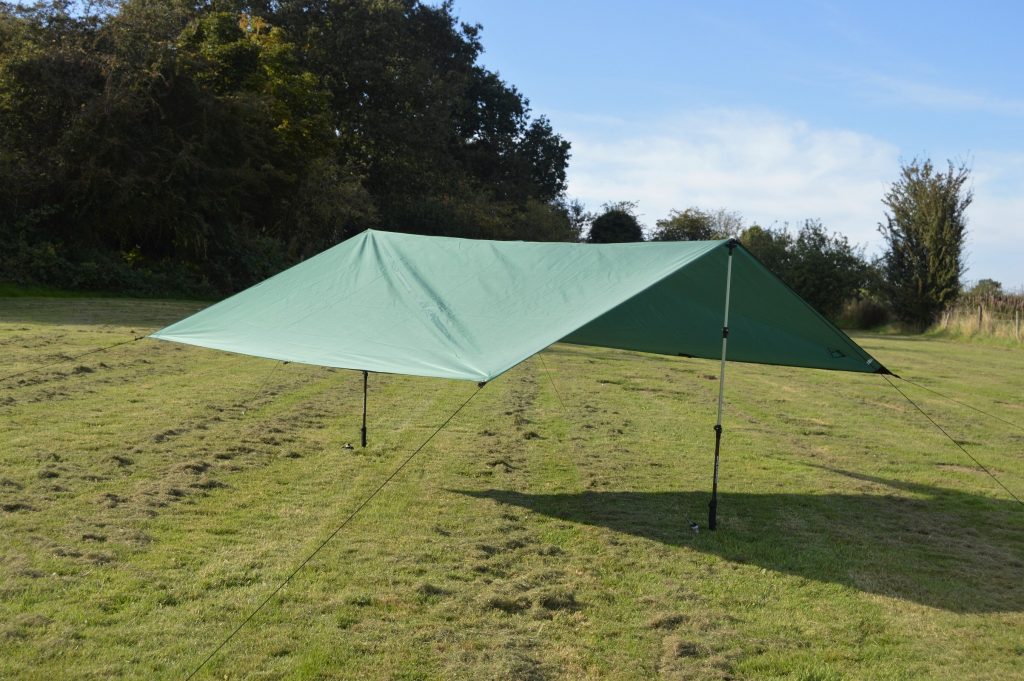Ready to go camping but don’t know how to put up a tarp without trees? Well, in this scenario, there are some methods that can help you create a shelter on the beach or in the open field, and we’ve got you covered. Below are the two basic methods you can learn to set up the tarp yourself.
Putting up the tarp in these two methods can help during downpours, strong winds, and cruel climates. Don’t worry, as the lack of trees won’t ruin your camping and won’t cause you a panic attack if you find yourself in a survival situation. In fact, it doesn’t require any special equipment, and you can do it yourself, even if you have very basic skills.

How to Put Up a Tarp Without Trees
Putting up a tarp without trees is essential for camping or just a survival shelter in any area. The basics include having any metal or plastic stake or a piece of branch, guy ropes, and poles to pin the tent.
Secure the ends of the tent by attaching them to the four eyelets and peg them into the ground. Place the tip of the pole in the middle of the tent and lift it, do the same with the other end of the tent and attach the poles to the ground.
Adjust the rope tension; the poles will be strong enough to hold the tarp up. For the primitive version, you can use any stick or a branch to hold the tent up.
Read on for step-by-step detailed guides on both methods.
Easy open tarp setup with metal poles
Necessary equipment
- Tarp
- Metal or plastic stakes to secure the tarp where there are no trees
- Guy ropes are necessary to hold the tarp down
- Large poles to hold your tarp up (depending on how open you want the tend to be)
- Position the tarp
First, you want to choose a suitable location to set up the tarp. Choose soft soil so it can be easy to pin down and secure enough in any weather.
Now spread the tarp on the ground and decide which side will be the entrance. Check the direction of the wind. It’s preferable to set your tent on the opposite side of the wind.
Put something heavy on the flysheet to prevent it from being blown away; however, avoid placing rock, as it can damage the cloth if the wind is strong.
- Secure the tarp down
Attach the guy ropes to the four eyelets and tie knots. Any knot will be fine; however, it’s best to tie a bow knot as it’s secure and it’s easy to untie.
Take a peg and walk about 45-degree angle away from the flysheet and pound the peg into the ground. Now attach the guyline to the peg and keep it a little bit loose. Repeat this to the rest of the three ends.
When it comes to the middle of the flysheet, you will do the same; only you have to set it 90 degrees away from the middle eyelets. Do this on both ends in the middle when you set the main poles to create stronger support.
- Lift the tarp
Once the tarp is secured, it’s time to lift the flysheet. If you are using metal poles, extend them to the desired height; however, for the tarp to be more secure, it’s advisable to keep the height of the poles as lower as possible. If the weather is colder, it will ensure more warmth inside.
Put the tip of the pole through the middle eyelet, lift up the flysheet, and attach the pole to the ground. Do the same with the other side of the flysheet.
Depending on how open you would want your tarp to be, you can add more poles on the sides.
- Adjust the rope tension
We’ve come to the final step. Adjust the guyline tension by tilting the tensioner and pulling the guyline. If necessary, adjust the peg location if you notice the sheet is wrinkled in a certain place.
When you are done, make sure the pegs are pounded into the ground so the tarp will endure bad weather and strong wind.
Read more: How to Put up a Tarpaulin
Primitive no tree tarp setup
Necessary equipment
- Tarp
- Ropes
- Stakes
- Branch or a stick
- Position the tarp
Spread the tarp sheet over an even surface. Now determine the direction of the wind, and do the same as in the previous method. Place something heavy on top to prevent the wind from blowing it off.
- Secure the back of the tarp
Generally, the tarp would have four attachment points; two in each corner and two in the middle. First, we will secure the two ends in the middle by inserting the stakes directly in the set’s attachment points. Make sure you stretch the sheet so the wind won’t blow inside the tent.
- Secure the front of the tarp
Now, you’ll have to go to the front of the tent and take the two uttermost corners, bring them up a little bit in the front and pin them in the ground.
Once you pin the first one, remove the heavy object you put on top of the sheet at the beginning. Take the other end of the front of the tend and pin it in the ground more on the front as you did with the previous one, so the top of the sheet will overlap a little.
Also read: How to Keep a Tarp From Collecting Water
- Lift the tarp up
In this step, you’ll need a branch or a stick that will be strong enough to hold up the tarp; however, make sure there are no rough edges so it won’t tear up the sheet. For this purpose, you can put a cloth on top of the branch to act as a cushion.
Now take one of the ropes that come with the tarp or use any string that can hold it and tie it in the center of the tarp but make sure it won’t damage it. Pin in the ground and leave it a bit loose.
Now place the branch under the cloth right in the middle of the tarp.
- Anchor the tarp
The final step in how to put up a tarp without trees is to make it strong enough to endure any weather. Once you lift the tarp, you’ll notice some loose sides you’ll need to secure. Push the stakes down on all the sides to anchor the tent and tuck in the ends of the sheet inside.
Additionally, you can add two ropes on the front of the tarp and anchor them to the back for better safety.
